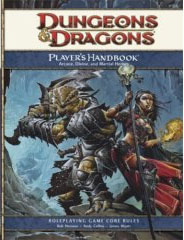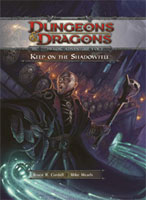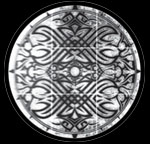 It seems crazy to say this, but I’ve been talking about Keep on the Shadowfell since May. That’s a lot of time to dedicate to a single adventure. But, of course, a lot of this time has also been spent reading, analyzing, playing, and talking about the 4th Edition ruleset.
It seems crazy to say this, but I’ve been talking about Keep on the Shadowfell since May. That’s a lot of time to dedicate to a single adventure. But, of course, a lot of this time has also been spent reading, analyzing, playing, and talking about the 4th Edition ruleset.
This essay is going to be about my playtesting of 4th Edition. Understanding these comments may require a little bit of context, however. So let’s start with that.
When 4th Edition was first announced in August 2007, I posted some Thoughts on 4th Edition. These primarily consisted of three points: (1) What WotC says about a new edition and what a new edition actually does are frequently two completely different things. (2) The design ethos being espoused at WotC did not fill me with confidence. (3) I wasn’t going to draw any conclusions until I actually had the rules in my hands.
In May of this year I wrote a series of essays on Dissociated Mechanics. These essays were written before 4th Edition was released, but provided a detailed dissection and analysis of what I still believe to be a serious flaw in the design ethos at WotC.
After the rulebooks were released, I revisited the subject of Skill Challenges. I was over-hasty in my reading of certain rules, but also far too forgiving in others (check the comment thread attached to that post).
If you’ve looked through some of this material, it will be clear that I had some serious reservations about 4th Edition. But I was also determined to approach the new system with an open mind. Ultimately you can talk a game to death, but it lives or dies in the playtest.
My initial intention was to take Keep on the Shadowfell and use the Quick Start Rules to play 4th Edition right out of the box — just as the designers intended it. I had high expectations that, with Mike Mearls and Bruce Cordell writing it, I would be able to just pick up the adventure and run it. Unfortunately, my first impressions of the module left me fairly disenchanted, and the 12-part series of remix essays should give some idea of the amount of work I had to put into the module before I felt comfortable running it.
Eventually, however, I was ready to go. And I have now run two separate playtests of the module: One for a group of experienced D&D players (my regular group) and another for a group of newbies (some of whom had never played an RPG before).
So let’s talk about my first reactions to playing 4th Edition.
COMBAT
Combat is the highlight of the game. It is interesting and dynamic. I was surprised, however, at the lack of a paradigm shift. Although the mechanics have been thoroughly shuffled, combats still largely play out the same way they did in previous editions.
One of the things promised in the preview material and hype, for example, was greater mobility in combat. But mobility has not noticeably increased at my gaming table. Some people claim that full-attacks resulted in 3rd Edition combats where people stood around and beat on each other, but that was never my experience: It was the desire to avoid attacks of opportunity that tended to lock opponents together (although this never stopped people from doing a lot of maneuvering at a small scale). Opportunity attacks are still in the game and, predictably, people are still trying to avoid them. And once you add marks into the mix, combat had a tendency to become less mobile, not more mobile.
The other major change that was promised was the ability to run combats involving large numbers of NPCs. But, personally, I’ve been running combats involving large numbers of NPCs for 20 years now. We did see a greater ability to run such encounters as 1st level characters, but that has more to do with 1st level characters playing more like 3rd level characters from previous editions than anything about the combat system.
PADDED SUMO WRESTLERS: There were also suggestions being made that combat in 4th Edition was going to be considerably faster. Even accounting for the slow-downs associated with acclimating to a new system, this was not our experience. Even basic encounters were chewing up huge chunks of time.
One of the primary reasons for this is that combats now resemble what I saw one person describing online as an “all-out brawl between heavily padded sumo wrestlers”. The number of hit points has been significantly increased and the expected damage output of the PCs has been significantly reduced.
The result was that we were very quickly seeing combats that had outlasted their welcome and degraded into “I hit him”, “I hit him again”, “I hit him again”, “I hit him again”, “… he’s still not dead? I hit him again”.
This problem appears to become exacerbated at higher levels.
MINIONS: My players were not impressed with the “prick ’em and they die” aspect of minions. They liked the target-rich environment, but the fact that they didn’t have to roll for damage made it feel as if they were never actually getting to land their blows.
They were also annoyed by the dissociated nature of the minion mechanics, which I found surprising because: (1) I wasn’t, and dissociated mechanics are probably my biggest problem with 4th Edition. And (2) It came from an unexpected direction. It wasn’t the fact that they only had 1 hp that yanked them out of the game world, it was the “never take damage on a miss” clause. This meant that they were making meaningful tactical decisions about which abilities to use based on whether a given target was a minion or non-minion — they were either bothered by the fact that they were making tactical decisions that didn’t map to their characters’ perceptions; or they were bothered by the fact that their characters had some sort of minion-detector.
Unknown to my players at the time of our 4th Edition playtest, I’d actually been developing a different set of minions rules for Legends & Labyrinths. Based on their reactions to the 4th Edition system, I’m glad that I decided to take a different direction.
FORCED MOVEMENT: The one element of the combat system that did feel as if it was adding a meaningful new dynamic to the game were the forced movement mechanics. The ability to shove people around the field of battle without suffering the rather heavy penalty of an attack of opportunity did give some unique flavor to 4th Edition combat.
We have not found forced movement to be particularly revolutionary, but this is also something that might change at higher levels when forced movement starts being more than 1 square at a time. Hard to say. If nothing else, it certainly encourages me to think that removing the attacks of opportunity from Bull Rush and similar maneuvers in 3rd Edition wouldn’t be a bad idea.
LEARNING THE GAME WITH KOBOLDS: I feel that kobolds were a bad choice to use for the initial villains in 4th Edition’s introductory product. In 4th Edition characters can take a standard action, a move action, and a minor action each round. And, as a move action, characters can shift (move 1 square without provoking opportunity attacks).
Kobolds, however, have a racial ability (Shifty) that allows them to shift 1 square as a minor action.
Any villain will probably have some ability that “breaks” the general rules, but this one was particularly confusing because it made it quite difficult for players to distinguish the general rules for shifting. Both experienced and newbie players were frequently trying to perform shifts as minor actions, only to remember (or be reminded) that the kobolds could only do that because of a racial ability. (And this was despite the fact that I was playing with open stat-blocks to help the players figure out the mechanics.)
PLAYTESTING 4th EDITION
Part 2: Running Combat
Part 3: Characters
Part 4: The Nova Cycle
Part 5: Dissociated Mechanics
Part 6: Skill Challenges
Part 7: Gutting Non-Combat
Part 8: Balance and Prep
Part 9: D&D is Dead, Long Live 4th Edition














